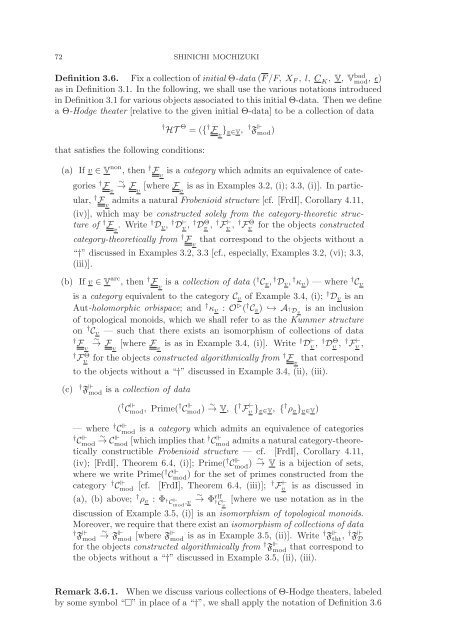Inter-universal Teichmuller Theory I: Construction of Hodge Theaters
Inter-universal Teichmuller Theory I: Construction of Hodge Theaters
Inter-universal Teichmuller Theory I: Construction of Hodge Theaters
You also want an ePaper? Increase the reach of your titles
YUMPU automatically turns print PDFs into web optimized ePapers that Google loves.
72 SHINICHI MOCHIZUKI<br />
Definition 3.6. Fix a collection <strong>of</strong> initial Θ-data (F/F, X F ,l,C K , V, V bad<br />
mod ,ɛ)<br />
as in Definition 3.1. In the following, we shall use the various notations introduced<br />
in Definition 3.1 for various objects associated to this initial Θ-data. Then we define<br />
aΘ-<strong>Hodge</strong> theater [relative to the given initial Θ-data] to be a collection <strong>of</strong> data<br />
that satisfies the following conditions:<br />
† HT Θ =({ † F v<br />
} v∈V , † F ⊩ mod)<br />
(a) If v ∈ V non ,then † F v<br />
is a category which admits an equivalence <strong>of</strong> categories<br />
† ∼<br />
F →Fv v<br />
[where F v<br />
is as in Examples 3.2, (i); 3.3, (i)]. In particular,<br />
† F v<br />
admits a natural Frobenioid structure [cf. [FrdI], Corollary 4.11,<br />
(iv)], which may be constructed solely from the category-theoretic structure<br />
<strong>of</strong> † F v<br />
.Write † D v , † Dv ⊢ , † Dv Θ , † Fv ⊢ , † Fv<br />
Θ for the objects constructed<br />
category-theoretically from † F v<br />
that correspond to the objects without a<br />
“†” discussed in Examples 3.2, 3.3 [cf., especially, Examples 3.2, (vi); 3.3,<br />
(iii)].<br />
(b) If v ∈ V arc ,then † F v<br />
is a collection <strong>of</strong> data ( † C v , † D v , † κ v )—where † C v<br />
is a category equivalent to the category C v <strong>of</strong> Example 3.4, (i); † D v is an<br />
Aut-holomorphic orbispace; and † κ v : O ⊲ ( † C v ) ↩→ A† D v<br />
is an inclusion<br />
<strong>of</strong> topological monoids, which we shall refer to as the Kummer structure<br />
on † C v — such that there exists an isomorphism <strong>of</strong> collections <strong>of</strong> data<br />
† ∼<br />
F →Fv v<br />
[where F v<br />
is as in Example 3.4, (i)]. Write † Dv ⊢ , † Dv Θ , † Fv ⊢ ,<br />
† Fv Θ for the objects constructed algorithmically from † F v<br />
that correspond<br />
to the objects without a “†” discussed in Example 3.4, (ii), (iii).<br />
(c) † F ⊩ mod<br />
is a collection <strong>of</strong> data<br />
( † C ⊩ mod, Prime( † C ⊩ mod) ∼ → V, { † F ⊢ v } v∈V , { † ρ v } v∈V )<br />
—where † Cmod ⊩ is a category which admits an equivalence <strong>of</strong> categories<br />
† Cmod<br />
⊩ ∼<br />
→Cmod ⊩ [which implies that † Cmod ⊩ admits a natural category-theoretically<br />
constructible Frobenioid structure — cf. [FrdI], Corollary 4.11,<br />
(iv); [FrdI], Theorem 6.4, (i)]; Prime( † Cmod ⊩ ) → ∼ V is a bijection <strong>of</strong> sets,<br />
where we write Prime( † Cmod ⊩ ) for the set <strong>of</strong> primes constructed from the<br />
category † Cmod ⊩ [cf. [FrdI], Theorem 6.4, (iii)]; † Fv ⊢ is as discussed in<br />
(a), (b) above; † ∼<br />
ρ v :Φ† C ⊩ → Φ<br />
mod ,v<br />
rlf<br />
† C<br />
[where we use notation as in the<br />
v<br />
⊢<br />
discussion <strong>of</strong> Example 3.5, (i)] is an isomorphism <strong>of</strong> topological monoids.<br />
Moreover, we require that there exist an isomorphism <strong>of</strong> collections <strong>of</strong> data<br />
† F ⊩ ∼<br />
mod<br />
→ F ⊩ mod [where F⊩ mod is as in Example 3.5, (ii)]. Write † F ⊩ tht , † F ⊩ D<br />
for the objects constructed algorithmically from † F ⊩ mod<br />
that correspond to<br />
the objects without a “†” discussed in Example 3.5, (ii), (iii).<br />
Remark 3.6.1. When we discuss various collections <strong>of</strong> Θ-<strong>Hodge</strong> theaters, labeled<br />
by some symbol “□” inplace<strong>of</strong>a“†”, we shall apply the notation <strong>of</strong> Definition 3.6
















